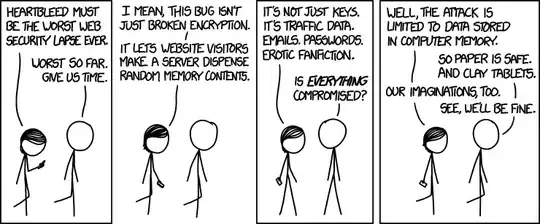There is more to consider than just new certificates (or rather, new key pairs) for every affected server. It also means:
- Patching affected systems to OpenSSL 1.0.1g
- Revocation of the old keypairs that were just supersceded
- Changing all passwords
- Invalidating all session keys and cookies
- Evaluating the actual content handled by the vulnerable servers that could have been leaked, and reacting accordingly.
- Evaluating any other information that could have been revealed, like memory addresses and security measures
Neel Mehta (the Google Security engineer who first reported the bug) has tweeted:
Heap allocation patterns make private key exposure unlikely for #heartbleed #dontpanic.
Tomas Rzepka (probably from Swedish security firm Certezza) replied with what they had to do to recover keys:
We can extract the private key successfully on FreeBSD after
restarting apache and making the first request with ssltest.py
Private key theft has been also demonstrated by CloudFlare Challenge.
And Twitter user makomk chimed in with:
I've recovered it from Apache on Gentoo as a bare prime factor in
binary, but your demo's a lot clearer...It has a lowish success rate,
more tries on the same connection don't help, reconnecting may,
restarting probably won't...Someone with decent heap exploitation
skills could probably improve the reliability. I'm not really trying
that hard.
I summarized the bullet points above from heartbleed.com (emphasis mine):
What is leaked primary key material and how to recover?
These are the crown jewels, the encryption keys themselves. Leaked
secret keys allows the attacker to decrypt any past and future traffic
to the protected services and to impersonate the service at will. Any
protection given by the encryption and the signatures in the X.509
certificates can be bypassed. Recovery from this leak requires
patching the vulnerability, revocation of the compromised keys and
reissuing and redistributing new keys. Even doing all this will still
leave any traffic intercepted by the attacker in the past still
vulnerable to decryption. All this has to be done by the owners of the
services.
What is leaked secondary key material and how to recover?
These are for example the user credentials (user names and
passwords) used in the vulnerable services. Recovery from this leaks
requires owners of the service first to restore trust to the service
according to steps described above. After this users can start
changing their passwords and possible encryption keys according to the
instructions from the owners of the services that have been
compromised. All session keys and session cookies should be invalided
and considered compromised.
What is leaked protected content and how to recover?
This is the actual content handled by the vulnerable services. It
may be personal or financial details, private communication such as
emails or instant messages, documents or anything seen worth
protecting by encryption. Only owners of the services will be able to
estimate the likelihood what has been leaked and they should notify
their users accordingly. Most important thing is to restore trust to
the primary and secondary key material as described above. Only this
enables safe use of the compromised services in the future.
What is leaked collateral and how to recover?
Leaked collateral are other details that have been exposed to the
attacker in the leaked memory content. These may contain technical
details such as memory addresses and security measures such as
canaries used to protect against overflow attacks. These have only
contemporary value and will lose their value to the attacker when
OpenSSL has been upgraded to a fixed version.
